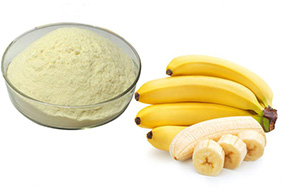[banana introduction]:
Banana is called Canna in ancient times. Its meat is soft and glutinous, sweet and delicious. It is said that Sakyamuni, the founder of Buddhism, gained wisdom because he ate bananas, so he is known as "the fruit of wisdom".

[main ingredients]:
Fruit powder.
[plant morphology]:
The plants of . The leaves are long and round, 2-2.2m long, 60-70cm wide, blunt and round at the apex, nearly round at the base, symmetrical on both sides, dark green on the leaf surface, without white powder, light green on the back and covered with white powder; the petioles are short and thick, usually less than 30cm long, with prominent wings, open, brown red or bright red on the edge. The spikes are drooping, the inflorescence axis is densely covered with brown villi, the outer part of the bracts is purple red, white powder, and the inner part is dark red, but the base is slightly light and glossy, the male bracts do not fall off, and each bract has two rows of flowers. The flowers are milky white or purplish, the free perianth segments are nearly round, entire, the apex has a cone-shaped sharp point, the middle two side of the syncytial perianth segments are long, about 1 / 2 of the central segment. The largest fruit cluster has as many as 360 fruits, weighing up to 32 kg. The general fruit cluster has 8-10 segments, about 150-200 fruits. The fruit body is curved and slightly arched. The young fruit is upward and upright. After ripening, it gradually tends to be flat, 12-30cm long, 3.4-3.8cm in diameter. The fruit edge is obvious, with 4-5 edges. The apex is gradually narrow, not significantly reduced. The fruit stalk is short, and the peel is greenish green. When ripening at high temperature, the peel is green with yellow color. When ripening at low temperature, the peel changes from green to yellow, and there are hemp black spots (i.e. "plum blossom") Point), flesh soft, yellow white, sweet, no seeds, very strong fragrance.
[distribution range]:
. Bananas are distributed in the tropical and subtropical regions within 30 ° of the northern and southern latitudes of the eastern, Western and southern hemispheres. There are 130 countries cultivating bananas in the world, with Central America producing the most, followed by Asia. Chinese bananas are mainly distributed in Guangdong, Guangxi, Fujian, Taiwan, Yunnan and Hainan. Guizhou, Sichuan and Chongqing also have a small amount of cultivation.
[chemical composition]:
The fruit contains 0.5% starch, 1.3% protein, 0.6% fat, 11% sugar, 1% ash, vitamin A, B, C, e, etc. It also contains a small amount of 5-hydroxytryptamine, noradrenaline and dihydroxyphenylethylamine. The leaves contain a small amount of tannin and cellulose 11.55%.